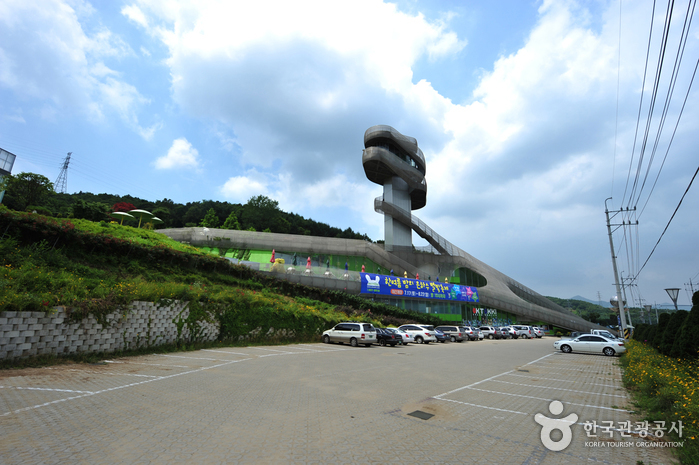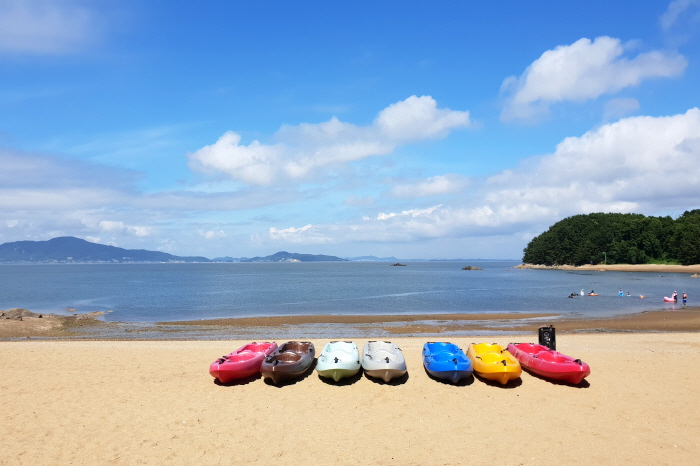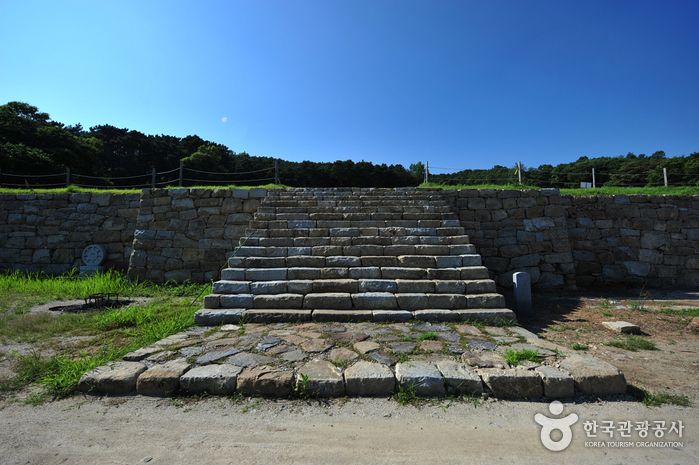Oktokki Space Center (옥토끼우주센터)
13.9 Km 29627 2020-06-01
403, Ganghwadong-ro, Ganghwa-gun, Incheon
+82-32-937-6917
Oktokki Space Center is Korea's first aerosepace theme park. The center collects, preserves, and exhibits materials related to aerospace engineering to educate and promote to the public. It is open to visitors all year round, offering diverse activity programs and experience rides that can be enjoyed by people of all ages. The center is especially well equipped with fun learning materials as well as educational programs to spark children's insterest in the field.
Wondumak Garden (원두막가든)
14.3 Km 18389 2024-02-27
60 Jeondeungsa-ro, Gilsang-myeon, Ganghwa-gun, Incheon
Wondumak Garden is a local cuisine restaurant in Ganghwa that has been delighting visitors since its establishment in 1990. Among its signature dishes are jeotguk galbi (salted shrimp and galbi soup) and sotbap (pot rice). Jeotguk galbi resembles a hot pot, incorporating pork galbi, pork bones, vegetables, and a salted shrimp-based broth. It is renowned for its non-spicy and clean-tasting broth, offering a distinctive and flavorful dining experience.
Sinsimodo Islands (신시모도 (신도ㆍ시도ㆍ모도))
14.6 Km 18020 2023-11-07
Bukdo-myeon, Ongjin-gun, Incheon
Sinsimodo Islands is comprised of the three islands of Sindo, Sido, and Modo. Referred to as brother islands, visitors can explore all three islands in one day on bicycle thanks to bridges that connect the islands together. Attractions on the islands include Gubongsan Mountain, Haedanghwa Dulle-gil Trail, Sugihaebyeon Beach, Baemikkumi Sculpture Park, and more. Gubongsan Mountain, located on Sindo Island, features a forest trail that is easy to walk on, making it easy to enjoy the azaleas and cherry blossoms that bloom each spring. Baemikkumi Sculpture Park, featuring artworks of Lee Ilho before the background of the sea, is especially popular among couples.
Sugi Beach (수기해변)
14.9 Km 14236 2022-07-28
291-48, Sido-ro 86beon-gil, Ongjin-gun, Incheon
+82-32-899-2253
Located on Sido Island in Incheon, Sugi Beach is easily accessible from Seoul. Sido Island is situated between Yeongjongdo Island and Ganghwado Island. The beach is not as crowded as other famous beaches, and is ideal for families or campers.
Sugi Beach was the filming location for the famous drama series "Full House (2004)." Sido Island connects Sindo Island and Modo Island, making it easy to tour the three islands by foot or car.
Gyodongdo Daeryong Market (교동도 대룡시장)
14.9 Km 4508 2023-11-08
35 Gyodongnam-ro, Ganghwa-gun, Incheon
+82-32-934-1000
Daeryong Market is an alley market that reproduces the appearance of Yeonbaek Market to maintain a livelihood for residents who temporarily evacuated from Yeonbaek-gun in Hwanghae-do, to Gyodongdo Island during the Korean War. Gyodongdo Island has been the center of economic development for over 50 years. As most of the displaced elderly who created the market passed away and the population rapidly decreased, the market size also reduced considerably. However, with the opening of Gyodongdaegyo Bridge in July 2014, it has become a must-see course for tourists to take pictures of Daeryong Market, which looks like a movie set in the 1960s. Gyodong Giga Island, also referred to as Gyodong Swallow House, opened in late march of 2022 and provides tour information using intellectual techonology as well as bicycle and smartwatch rental services to tourists. In addition, there are various experience programs such as a VR video experience and "Making Gyodong Newspaper."
Ganghwa Gyodongdo Island (교동도(강화))
14.9 Km 51959 2021-06-16
35, Gyodongnam-ro, Ganghwa-gun, Incheon
+82-32-934-1000
Gyodongdo Island is located northwest of the larger Ganghwado Island, and was made more accessible with the opening of Gyodongdaegyo Bridge in July 2014. The name changed with different dynasties, being Gomokgeunhyeon during the Goguryeo Era and Gyodonghyeon under the reign of Silla King Gyeongdeok. The island served as an important stopover point for ambassadors and envoys heading to China. Popular attractions on the island now include Daeryong Market, an alleyway market decorated with colorful murals and statues, and Manghyangdae Memorial, a gathering place for refugees who fled from the nearby Hwanghaedo Island during the Korean War. Many of the houses on Gyodongdo Island have swallow nests under the eaves. The refugees consider the swallows as guests from their hometowns. As such, the island is home to the "peace & reunion" themed Gyodong Swallow House, Peace Trail, and Gyodong Studio. Gyodong Swallow House serves as an exhibition and performance space. The Peace Trail is a biking path around the island. At Gyodong Studio, visitors can put on old school uniforms and take black-and-white photographs.
Hwagae Garden (화개정원)
15.0 Km 0 2024-02-20
6-60 Gyodongdong-ro 471beon-gil, Gyodong-myeon, Ganghwa-gun, Incheon
Hwagae Garden is a park situated on the foothills of Hwagaesan Mountain in Gyodong-myeon. Exploring the trails, visitors can immerse themselves in the ever-changing beauty of Hwagaesan Mountain across the seasons. Opting for the monorail to reach the observatory rewards with a panoramic view extending to Ganghwado Island. The park is equipped with various amenities, including walking paths, a lawn, a children's playground, along with restaurants and cafés.
Baemikkumi Sculpture Park (배미꾸미조각공원)
15.2 Km 1718 2016-10-28
41, Modo-ro 140beon-gil, Bukdo-myeon, Ongjin-gun, Incheon
+82-32-752-7215
Baemikkumi Sculpture Park rests on Modo Island, one of the nearest islets to Yeongjongdo Island where Incheon International Airport is located.
The name 'baemikkumi' comes from the local dialect, as people say the island resembles the shape of a hole normally seen from the bottom of a ship as 'baemit' translates to the bilge, and 'kkumi' is most closely translated to mean 'a hole' in English.
The entire island has now become a beautiful exhibition hall of art works thanks to sculptor Lee Il-ho, who originally started and donated his talents for visitors coming to the island. The art displayed on the island makes for an inspiring contrast to Seohae (west sea, or yellow sea) in the background.
Ganghwa Luge (Ganghwa Seaside Resort) (강화루지(강화씨사이드리조트))
15.2 Km 0 2023-11-10
217 Jangheung-ro, Ganghwa-gun, Incheon
+82-32-930-9000
Ganghwa Seaside Resort delivers joy, happiness, and love with a gondola, food court, themed trails and the only luge track in the western part of the metropolitan area. It is a place where visitors can meet the mountains and the sea and feel the profoundness of nature without having to travel far way from the city. Visitors can take the gondola to reach the top, guided by the rich scent of the forest, and fully enjoy the atmosphere of Ganghwado Beach as well as the beautiful sunset from the observatory. The resort has a luge designed to descend dynamically through a 1.8-kilometer track, offering an excitement perfect for all members of the family.
Ganghwa Seonwonsa Temple Site (강화 선원사지)
16.0 Km 12516 2022-09-19
222, Seonwonsaji-ro, Ganghwa-gun, Incheon
+82-32-933-8234
Ganghwa Seonwonsa Temple Site was first discovered in 1976 during a surface examination around Ganghwado Island undertaken by the Ganghwado Island Academic Research Team of Dongguk University. The site was designated as Historic Site No. 259 in 1977. Seonwonsa Temple was built by General Choi Wu in 1245 (the 32nd year of King Gojong’s reign during the Goryeo dynasty), which was right after the transfer of the capital to Ganghwado during resistance against the Mongolian invasion.
The temple was meant to be a spiritual mainstay in fighting against Mongolia. It used to be one of the two largest temples in Korea along with Songgwangsa Temple. However, the temple was completely destroyed during the early Joseon era, leaving only the site itself. The famous wood blocks of Palman Daejanggyeong (the Tripitaka Koreana), currently housed in Haeinsa Temple at Hapcheon, are said to have been originally stored in Seonwonsa Temple. It is believed that the carved wood blocks were taken from Seonwonsa to Heungcheonsa Temple during the Joseon era and again moved to Haeinsa Temple during the reign of Sejo.
Located on a mountain slope, the presumed location of the building site extends 250 meters from south to north and 170 meters from east to west.




 English
English
 한국어
한국어 日本語
日本語 中文(简体)
中文(简体) Deutsch
Deutsch Français
Français Español
Español Русский
Русский